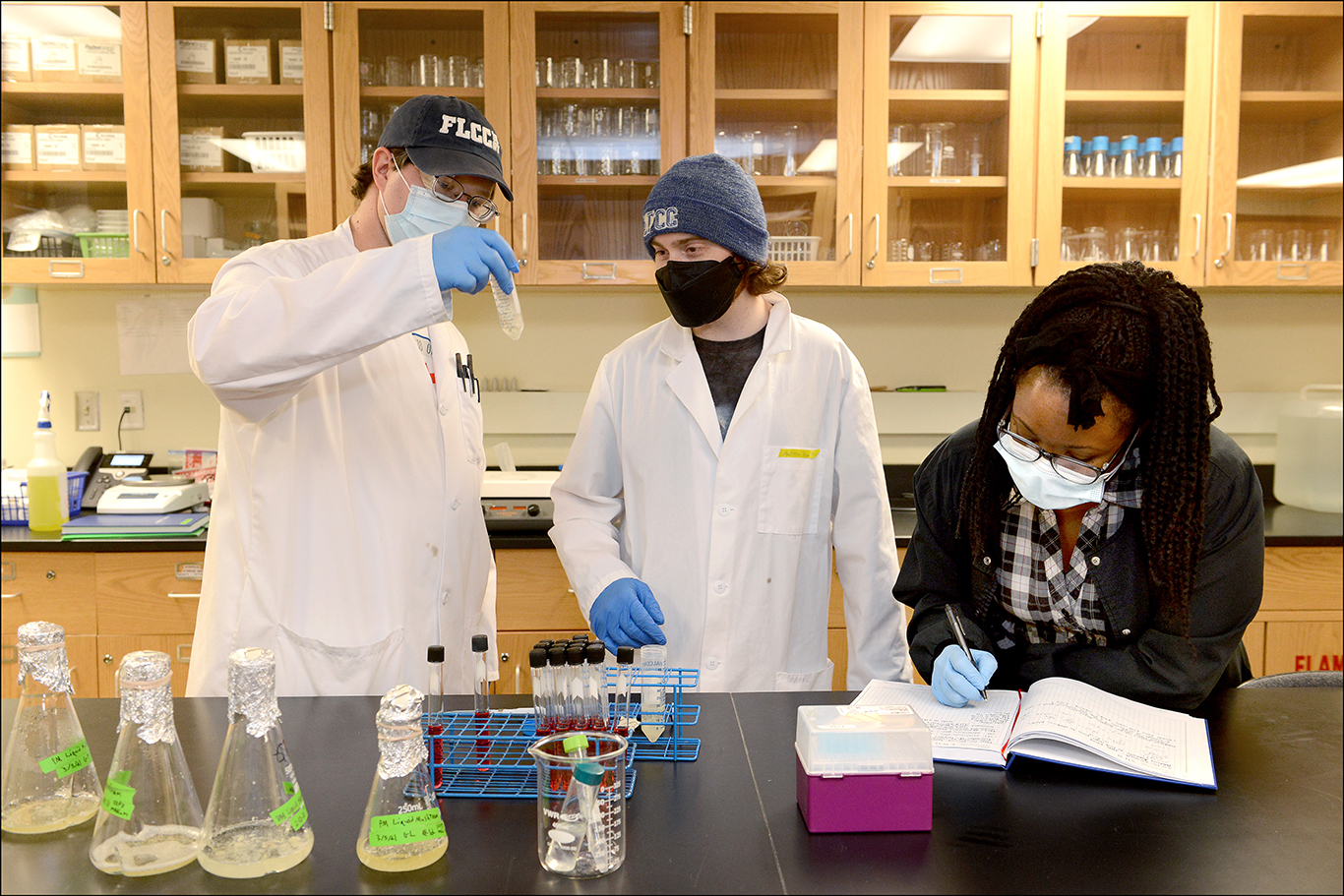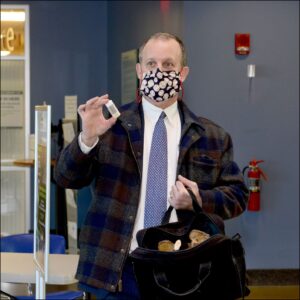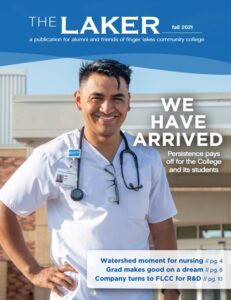The College is helping a company determine if there is a faster way to grow the nutrient-dense root-like parts of mushrooms.

Demetrice Garcia carefully positions a large flask of orange liquid in an autoclave, an oven-like device, to sterilize it for growing another batch of mushroom fibers.
Demetrice, or “Demi,” and her fellow research assistants, Philip Simmons and Matthew Brooks, are culturing mycelia, the white root-like filaments that, in the wild, extend from mushroom caps into rotting logs.
They work in the lab at Finger Lakes Community College, trying to answer questions that could lead to a number of commercial products: What conditions promote the fastest growth of mycelia and the bioactive compounds these fibers produce?
Their work is supported by the National Science Foundation, which funds a variety of programs to promote science education and opportunities for students to pursue careers in science. The exciting part is that this is not a lab exercise.
Real-world research
A local company is keenly interested in what they learn. Empire Medicinals in the Rochester suburbs grows gourmet mushrooms under the brand Leep Foods. The company sells them to stores and restaurants. It also roasts, grinds, and blends the caps and stems into chicken sausages and beef burgers to create leaner, more healthful versions.
Empire Medicinals is exploring a faster way to grow the mushroom mycelia – via fermentation in tanks – both for its food business and the aspiration behind its name: the dietary supplement market. Mushrooms are well established as a health food; they are low in calories and high in fiber, protein and antioxidants. Sugars they produce, called beta-glucans, are studied for their potential to boost the immune system, lower cholesterol and fight cancer.

Isolating the sugars requires growing the mycelia in a broth-like medium, separating the liquids and solids, then filtering the liquid. The problem for Empire Medicinals is that it has no lab, no bioreactor for growing mushroom fibers, and no filtration equipment. Buying equipment for exploratory research is expensive and risky for a young company.
Through mutual connections, Chris Carter, executive vice president, met James Hewlett, a biology professor and founder of the Community College Undergraduate Research Initiative, or CCURI. Jim has long championed the use of research to teach scientific principles and techniques. The mushroom project is a perfect example of how biotechnology research can yield a commercial product.
“This is called ‘proof of concept,’” Jim explained. “A lot of startups do not have large budgets for research and development, so they partner with institutions.”
“We’d have no capacity if we were not aligned with university processes,” Chris agreed. Companies commonly work with large research universities, but thanks to CCURI, community colleges can get in on this action.
The National Science Foundation (NSF) has awarded FLCC about $7 million to fund CCURI over the last 15 years to develop and share its model for teaching science through research. What began as a pilot project in 2006 among FLCC and four partner schools has become a national network of dozens of community and technical colleges that give more than 6,000 community college students the opportunity to engage in research each year.
FLCC has also received NSF funding through the Northeast Biomanufacturing Center and Collaborative, including $141,000 for the mushroom project with its partner Montgomery County Community College in Blue Bell, Pa.
The funding pays for training, equipment, even salaries for research assistants like Demi, Philip and Matthew. Over the summer, FLCC received a shipment of filtration equipment necessary for the next phase in their research process with Empire Medicinals.

In the lab
Jim, adjunct faculty member Sarad Parekh, and instructional specialist Jessica Halliley direct and mentor students as though they are working in a research and development lab.
“Their role is to develop, implement and analyze experiments and research protocols designed to get a better understanding of how to optimize the production of fungal exopolysaccharides from mushroom mycelia,” Jim said.
They start with a liquid growing medium and add the mycelia of one of two types of Ganoderma mushrooms that are part of the research project. Each batch goes into a bioreactor, a device for culturing organisms that allows researchers to manipulate variables such as temperature, nutrient content, pH, and oxygen.
After a set period – usually 14 days – the team evaluates how much the fibers grew and the quantity of beta-glucan. The liquids and solids are separated and measured. The liquid, or broth, is filtered for the beta-glucan. They change one or more variables and do it again. Time will tell how changes in the variables affect the output and what the optimal growing conditions are.
The process is repetitive; the exciting part is the original nature of the research. “Each time you do it, you never know what the end will be,” Matthew said.
The students learn how to use laboratory equipment and keep highly detailed records so their work can be replicated.
“The students are getting a chance to implement good manufacturing practices and good laboratory practices with this project in the lab, mimicking the standards that companies use in large scale biomanufacturing,” Jessica said. “This is important because it lets them practice what they learn briefly in our biomanufacturing courses on a longer-term, in-depth level, and gives them broad training for entry into future positions in the industry.”
They also get a thrill out of knowing they are now players in a global industry.
“I absolutely love it,” Demi said.
Philip said the experience has given him confidence in lab techniques he had only read about in classes that had moved online at the start of the COVID-19 pandemic.
Matthew agreed, adding that time in the lab leads to greater dexterity in handling equipment. A 2021 graduate, he plans to transfer and study biology at SUNY Geneseo, close enough to continue working on the FLCC project.
“It is a great learning experience,” he said. “It’s so far above and beyond what you learn in classes, especially with COVID.”
“The students are doing great,” Jim said. “As with any novel project, they took about a month to get really comfortable, but are doing some great work now and things are moving along.”
The next step

Work in the FLCC biotechnology lab will continue through August 2022. By then, the FLCC faculty and the team at Empire Medicinals hope to have enough data from the students’ experiments to determine the most promising process for a manufacturing demonstration.
The groundwork for that demonstration was laid earlier this year when representatives from the Center of Excellence for Food and Agriculture at Cornell AgriTech and Ontario County Economic Development visited the FLCC lab.
Cornell AgriTech helped Empire Medicinals develop its mushroom blended products and will collaborate with the company to scale up the mycelial fermentation and filtration process. The manufacturing process will yield two products: the solid material, the fibers themselves, for use in their blended meat or other food products and purified beta-glucan to sell as a dietary supplement.
While other companies sell beta-glucans, Empire Medicinals is focused on developing a niche product within that market and a process that provides a competitive advantage. “If we are looking at the fastest way to get the beta-glucans, broth is the best,” Chris said.
Down the road, the company would like to use whey, a waste product in the dairy industry, as an inexpensive, abundant growing medium. The College’s research team is specifically testing a type of mushroom that can grow in whey.
While Chris looks forward to the final data, he is enjoying the partnership.
“We showed up with a research objective that met the College’s academic needs,” he said. “We are doing research together.”
FLCC will hand off the project to Cornell Agritech, backed by the institutional knowledge and resources of Cornell University.

“We can’t miss what is happening here,” said FLCC President Robert Nye. “Jim Hewlett’s work in developing CCURI, in getting those National Science Foundation grants, has opened the door for FLCC and other community colleges to participate in a broad network of institutions, companies and economic development agencies engaged in innovation. Our students get access to that network and I’m just thrilled to think where it can take them.”

